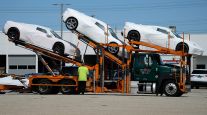Economy Expands at Faster Pace Than Expected in Fourth Quarter

The U.S. economy unexpectedly expanded at a faster pace in the fourth quarter than estimated, reflecting a higher value of business inventories.
Gross domestic product, the value of all goods and services produced, grew at a 1% annualized rate compared with an estimate of 0.7%, Commerce Department figures showed Feb. 26. The median forecast in a Bloomberg News survey called for a 0.4% gain. Consumer spending was revised lower.
Although the economy slowed in the fourth quarter from 2% in the previous three months, growth is projected to re-accelerate this year as consumers tap into the benefits of a strengthening job market and savings on gasoline to boost spending. With companies making less headway in adjusting stockpiles, one risk for the economy is further weakness in manufacturing and business investment.
“This inventory correction keeps surprising us — it keeps dragging on,” said Nariman Behravesh, chief economist at IHS Inc. in Lexington, Massachusetts, who is the top forecaster of GDP over the past two years according to data compiled by Bloomberg News. “If the inventory drag continues into the first quarter, the first quarter could be a little bit weaker because you get that spillover. The fundamentals are still pretty solid, but there clearly are some short-term wobbles. ”
Economists’ estimates in the Bloomberg survey ranged from annualized growth rates of 0.1% to 0.9%. The GDP estimate is the second of three for the quarter, with the other release scheduled for next month when more information can be incorporated. The revision shows GDP expanded 2.4% in 2015.
The changes to fourth-quarter growth largely reflected how unsold goods are valued. In inflation-adjusted terms, there was more inventory accumulation than previously estimated as underlying price data were revised up.
Inventories grew at an $81.7 billion annualized rate from October through December and reduced growth by 0.14 percentage point, compared with a previously reported 0.45 percentage-point drag.
The trade gap also weighed less on growth than earlier estimated. The difference between exports and imports shaved 0.25 percentage point from growth, primarily due to fewer goods shipments from overseas. It previously was estimated to have subtracted 0.47 percentage point.
Stripping out inventories and trade, the two most volatile components of GDP, so-called final sales to domestic purchasers increased at a 1.4% rate, compared with a previously reported 1.6% pace.
Household consumption, which accounts for almost 70% of the economy, grew at a 2% annualized rate, weaker than the 2.2% pace initially estimated.
The report also included revisions to third-quarter personal income, which held less encouraging news for consumers. Wages and salaries rose by $78.2 billion from the previous three months, revised down from an initially reported $103.9 billion gain. They increased by an additional $83.3 billion in the fourth quarter.
Nonresidential fixed investment decreased at a 1.9% annualized rate, little changed from a previously estimated 1.8% decline.
A separate report this week indicated that the investment slowdown may be easing. Orders for capital equipment, a harbinger of business spending on things such as machinery and computers, jumped in January after plunging to a more than two-year low at the end of 2015, figures from the Commerce Department showed Feb. 25. The report corroborated recent, more upbeat, manufacturing production and employment figures that had been called into question as surveys showed confidence among factory managers was sinking.




